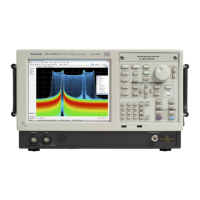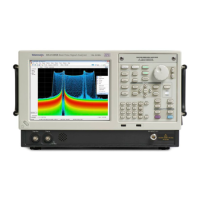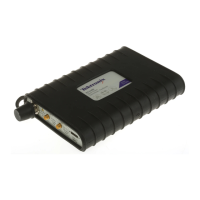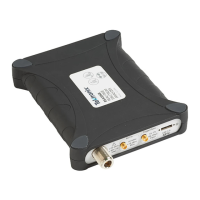Performance Verification
Ref Level
Setup > Amplitude > Internal Settings > Ref
Level
–15 dBm
Internal Attenuator
Setup > Amplit
ude > Internal Settings
10 dB (Auto unc
hecked)
Span
Setup > Settings > Freq & Span > Span
1MHz
LF Path
Setup > Acquire > Input Params
Use Low Freq
box checked
6. Set the RF generator for a –14 dBm output amplitude and turn RF On.
7. Set both the RF signal generator output frequency and the RSA5100B Center
Frequency to the first frequency shown in the table Low Frequency Input Path
Flatness (Preamp Off, if installed). (See Table 73.) This is the reference
frequency.
8. Select the Peak key on the Markers control bar to set the Reference Marker
(MR) to the carrier peak.
9. Adjust the RF signal generator output level for a maker reading of
–20 ± 0.5 dBm.
10. Record the Power Meter reading and the RSA5100B marker reading in the
following table.
11. Set both the RF generator output frequency and the RSA5100B Center
Frequency to the next frequency in the table.
12. Select the Peak key on the Markers control bar to set the Reference Marker
(MR) to the carrier peak.
13. Record the Power Meter reading and the RSA5100B marker reading in the
following table.
14. Calculate the Δ Power Meter number: subtract the Power Meter reading at
10 MHz from the Power Meter reading at this frequency.
15. Calculate the Δ RTSA number: subtract the RTSA reading at 10 MHz from
the RTSA reading at this frequency.
16. Calculate the RF Flatness Error:
RF Flatness Error = Δ RTSA at this freq - Δ Power Meter at this freq
Readings are in dBm, error is in dB.
17. Repeat parts 11 through 16 for each of the center frequencies shown in the
following table.
96 RSA5100B Series Technical Reference

